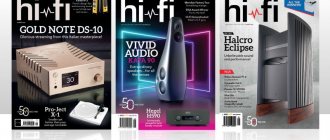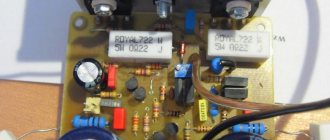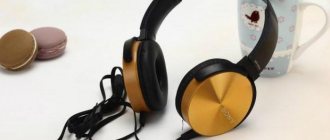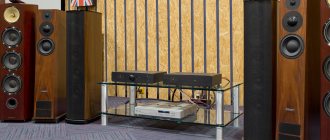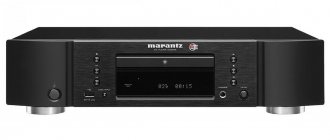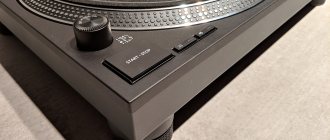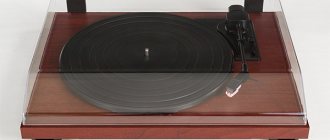Prestige Series MI-type phono head
The updated Grado Silver3 and Grado Gold3 heads have a new coil design, and the effective mass of their moving systems has been reduced by 17%. The Grado Silver3 and Grado Gold3 feature a four-piece matched cantilever (OTL cantilever), ultra high-purity long crystalline oxygen-free copper (UHPLC) coil conductor, and Grado-specific elliptical needles mounted in brass bushings. Pickups labeled Grado Prestige Gold3 are tested from the Grado Silver3 run and meet higher specifications and requirements. About 5% of products meet these standards and become Grado Gold3 models.
The Prestige Series is designed for high output levels and excellent long-term stability. A significant reduction in the mass reduced to the tip of the stylus made it possible to expand the frequency range to 50 kHz and higher with a stylus clamping force of 1-2 g. Grado Prestige series pickups are noted by experts as the best in the world in their price category. Prestige series head models are available with both P-Mount and half-inch mounts. Inserts are replaceable.
Reviews of Grado Prestige Gold3
“The sound of the Gold 3 head is easily recognizable, but after a few minutes of listening it ceases to matter, the music itself is so captivating.” – Wayne Garcia – The Absolute Sound
“Without a doubt this is the best purchase for the money!” – Hi-Fi Choice / Alan Sircom
“What many lesser quality heads fail to do was not a problem for Grado.” – – Hi-Fi Choice / Alan Sircom
“The sound was lively and detailed, but not at all harsh on vocal sibilance, and the plucking attack of the acoustic guitar strings did not seem overly accentuated.” – Hi-Fi Choice / Alan Sircom
“While the Prestige Gold doesn't have the same ultra-refined feel or heightened audiophile pleasure as the most expensive MC heads, it will get you most of the way to analog perfection, and for a fraction of the price." – Chris Martens / The Absolute Sound
Grado Gold performs music in a way that is surprisingly easy to live with and comfortable to listen to. It doesn't throw sounds right in your face like many other pickups, but leaves the inherent live character of any music intact. For this reason, Grado Gold will fit into a great variety of audio systems. Undoubtedly the best buy. Alan Sircom, Hi-Fi Choice magazine Best Buy nominated October 1996
Review of Grado Prestige Gold1 >>
Characteristics
- Frequency range: 10 Hz – 60 kHz
- Head type: MI
- Channel crosstalk at 1 kHz: 35 dB
- Input Impedance: 47K
- Output voltage at 1 kHz: 5 mV
- Recommended clamping force: 1.5 g.
- Stylus type: E
- Inductance: 45 mH
- Resistance: 475 ohms
- Weight: 5.5 g.
Interactive history of Grado
Grado Pickup Features
"Truly the world's best headphones and pickups"
All Grado pickup models are based on the principle of a moving magnetic circuit (Moving Iron) and embody patented technologies:
- OPTIMIZED TRANSMISSION LINE – in the needle holder design
- PIVOTED FIXED AXIAL STYLUS-GENERATOR MODULE (pivoted fixed axis generator module)
- FLUX-BRIDGER GENERATOR SYSTEM (generator system with magnetic flux distribution)
- Needle holder type OPTIMIZED TRANSMISSION LINE (OTL)
Grado OTL technology ensures ideal transmission of mechanical vibrations (signal) from point to point, i.e. from the needle point through the needle holder to the magnets and coils. Ideal transmission is achieved by eliminating resonances at each critical node in this circuit. The OTL needle holder consists of separate sections that fit into each other to form a telescopic structure. The sections are made of various alloys, some sections are solid, others are hollow. The sections are connected to each other using damping materials. They are coated on the outside with a proprietary black compound that absorbs resonances traveling across the surface of the needle holder (a phenomenon known as skin effect). Thanks to the needle holder of the OTL design, vinyl records sound with less noise, the transmission of high frequencies, depth and width of the stage, and detail are improved. The sound panorama acquires a holographic volume, and the listener’s perception of the music becomes more emotional.
The Best Pickups - Part II
Home » Best Pickups - Part II
Miyajima Shilabe phono cartridge
Shilabe's strengths are so obvious that it can easily compete with more expensive products. Other cartridges also have their strengths, but the Shilabe's sound has its own great advantages when listening to records on a prepared stereo system.
| Miyajima Labs is located in Fukuoka-shi, Japan. Its owner, Mr. Noriyuki Miyajima, personally collects all of his cartridges. | |
| The cross ring method is a great way to get natural sound. The pickup design uses patented technology, the main principles of which are to eliminate the influence of the coil on the magnetic field in the pickup, as well as free rotational movement of the coil for the most accurate signal generation. | |
| Description: Moving coil pickup, low voltage output, low compliance. | |
| Impedance: 16 ohms. | |
| Frequency range: 20Hz ~ 32kHz (-3dB). | |
| Downforce: 2.5g ~ 3.2g (3.0g recommended). | |
| Nominal output voltage: 0.23 mV. | |
| Diamond needle: Shibata sharpening shape. | |
| Needle holder compliance: 5 x 10-6 cm/dyne (100 Hz). | |
| Weight: 10.4 g. | |
| Body: African ebony. | |
| Price: $2800. | |
| Shilabe is fantastic and a must listen if it's in your price range. |
Ortofon MC-2000 MC pickup
First of all, it should be noted that the Ortofon MC-2000 pickup has extraordinary performance across the entire audio range. The Shure V-15 cartridge no longer has a monopoly on incredible record reading capabilities! In addition, the MC-2000, like all similar low-voltage output cartridges, depends on the quality of the step-up transformer.
| It is probably worth trying, in addition to the existing transformer, other models of step-up devices. | |
| This cartridge does everything right that all other MC cartridges would do wrong or almost right but not quite right. Its spectral balance, being completely neutral, is excellent; it is neither warm nor cold, neither bright nor sweet. The sound stage is striking in its stability, accuracy, depth and volume. | |
| Description: Moving coil pickup with low voltage output. | |
| Output: 0.05 mV. | |
| Recommended load: 20-100 Ohms. | |
| Frequency response; 5Hz ~ 50kHz (+5/-1dB). | |
| Channel separation: 25 dB (at 1 kHz) and 18 dB (at 20 kHz). | |
| Equivalent pen tip weight: 0.27 g. | |
| Downforce: 1.5g (1.2~1.8g). | |
| Tracking Angle: 20 degrees. | |
| Load resistance: 20 ~ 100 ohms. | |
| Weight: 11 gr. | |
| Price: $1000 (1985); no longer available since 2010. |
Linn Klyde Moving-Coil Pickup
| The Linn Klyde moving coil cartridge is a high performance cartridge designed for high quality music extraction from vinyl media. | |
| Moving coil cartridges generate a lower voltage output signal than moving magnet cartridges and should be used in conjunction with step-up transformers such as the Linn Linto. | |
| The Klyde signal generating cartridge has a highly sensitive sensor, a high-precision suspension consisting of a console and a diamond stylus, all this guarantees minimal presence of surface noise and a long service life. | |
| For better fixation, the pickup has an aluminum alloy body. | |
| Description: Moving coil pickup with low voltage output. | |
| Dynamic compliance: 10 x 10 (-6) cm/dyne | |
| Recommended load: >50 ohms | |
| Output: 150 mV. | |
| Separation at 1 kHz: >30 dB | |
| Channel Balance: Within 0.5 dB | |
| Downforce: 1.55~1.75g. | |
| Connection: 1.2mm gold plated pins | |
| Weight: 8 gr. | |
| Recommended tonearm: Medium weight, rigid | |
| Price: $1095 | |
| Manufacturer: Linn Products, Ltd, Glasgow, Scotland. |
Pickup Grado Prestige Gold1
The upgraded Grado Prestige Gold1 pickup comes with an updated coil design. Their effective mass has been reduced by 17%. The pickup utilizes a four-piece stylus holder (OTL cantilever), high purity oxygen-free copper (UHPLC) coil guide, and engineered elliptical styli mounted in brass bushings. Pickups labeled Grado Prestige Gold1 are tested from the entire Grado Silver1 run and meet the highest specifications and requirements.
The Grado Gold1 pickup is an MI (iron displacement) type. The only noticeable difference between a cartridge type (MM) and a moving iron type (MI) cartridge is the presence of a small piece of iron or other ferroalloy that replaces the magnet at the end of the needle holder.
| Since iron is lighter than magnet, the tracking force can be reduced while simultaneously increasing tracking accuracy and ultimately improving playback quality. | |
| The Grado Gold doesn't throw sounds in your face like many other pickups, but leaves the inherent live character of any music intact. For this reason, Grado Gold will fit into a great variety of audio systems. Without a doubt, the Grado Prestige Gold1 pickup is the best buy. | |
| Description: Moving iron type (MI) pickup. | |
| Frequency range: 10Hz~60kHz | |
| Output voltage: 5.0 mV. | |
| Recommended load: 47 kOhm. | |
| Internal resistance: 475 Ohm. | |
| Inductance: 45 mH. | |
| Channel separation: 35 dB (1 kHz). | |
| Dynamic compliance: 20 x 10 (-6) cm/din. | |
| Needle shape: Ellipse. | |
| Recommended downforce: 1.5 g. | |
| Weight: 5.5 g. | |
| Price: $220. | |
| Manufacturer: Grado Labs, Brooklyn, NY. |
Ortofon SPU 90th Anniversary pickup
In the early 1950s, Fonofilm became Ortofon. And she began designing moving coil pickups, which are still considered the best in both professional and home use. Since 1959, Ortofon has manufactured best-selling tonearms, step-up transformers and cutting heads. In English, SPU means Stereo Pickup Unit.
The Ortofon SPU 90th Anniversary version was developed for the 90th anniversary of Ortofon and has a new magnetic system. The elliptical diamond is mounted on an aluminum console.
| The coil is wound with 99.9999% pure copper (6N) wires, and the internal wiring with gold-plated connectors is 99.9999% pure silver (6N). | |
| For the first time in history, the SPU has been assembled using an all-new patented magnet system that retains all of the pickup's superior characteristics. | |
| Features: One part of the pickup body is directly connected between the generator system and the wooden body. Providing a perfect rigid connection and extremely high internal damping. An exposed elliptical diamond adorns the aluminum cantilever, continuing the Ortofon SPU tradition, along with a black polished wood body. | |
| Sound reproduction is unsurpassed in its neutrality, detail and dynamic range. |
Description: SPU anniversary series pickup. Output voltage: 0.3 mV (1000 Hz, 5 cm/sec).
Channel balance (1 kHz): <1 dB. Channel separation: >23 dB 35 dB (1 kHz) and >15 dB (15 kHz).
Frequency range: 20Hz~30kHz(-3dB) and 20~20000Hz±2dB. Recommended load: 10 ~ 50 ohms.
Internal resistance: 2 ohms. Dynamic compliance: 10 x 10 (-6) cm/din.
Tracking Angle: 20 degrees. Needle sharpening radius: 8/18 microns. Needle sharpening type: Elliptical.
Recommended downforce: 2.5~3.5g. Reliability of needle tracking in the groove (tracability): 315 Hz.
Coil wire material: silver plated copper. Pickup body: pressed wood.
Weight: 30 gr. Price: US $2,500.00 (ebay). Manufacturer: Ortofon A/S, Denmark.
Miyabi 47 pickup
The concept of Miyabi originated in Japan during the medieval period, when artists, writers, poets and intellectuals were concerned about the tide of ignorance, barbarism and moral degradation that was infesting their culture. In response, they nurture and exalt their unique national values of beauty, nobility and enlightenment at the very heart of their culture. Miyabi is one of these meanings.
Master Haruo Takeda is an independent designer who, under his own brand name "Miyabi", crafts moving coil (MC) cartridges that deliver incredible performance. He also designs electronic components for other manufacturers such as Krell, Mark Levinson and Cello.
| In recent years, Haruo Takeda has been making MIYABI pickups specifically for the Japanese and its American distributor Sakura Systems. | |
| Description: Miyabi 47 moving coil pickup with low voltage output. | |
| Frequency range: 20Hz~20kHz. | |
| Output: 0.3 mV. | |
| Channel separation: >25 dB (1 kHz). | |
| Console: Aluminum. | |
| Needle shape: Contact, linear. | |
| Recommended downforce: 2.0 g. | |
| Coil wire material: Copper. | |
| Pickup body: special aluminum alloy. | |
| Weight: 13 gr. | |
| Price: $4400. | |
| Manufacturer: Haruo Takeda. |
Pickup EMT OFD 65
Magnetic pickups designed to play 78 rpm records are still available from six manufacturers: EMT, Grado, Ortofon, Rega, Shure and Stanton. EMT and Ortofon are probably the only companies that specifically produce pickups for 78 rpm records.
In 1989, EMT was purchased by the famous Belgian company Barco. Since August 2003, the “new” EMT began its activities under the name EMT Studiotechnik GmbH. The main activity is the promotion of audio technology. On the one hand, this is concern for previously released products, on the other hand, the further development of advanced audio technologies. New systems are still being produced. Almost all EMT devices are serviced and repaired in the same way.
The EMT OFD 65 moving coil cartridge is specially designed for playing records at a rotation speed of 78 cm/sec with a recommended tracking force of 9 g. and a spherical needle. The pickup body is made of aluminum alloy and has a built-in magnifying glass with high magnification and a miniature screen. The magnifying glass shows a large image of the surface of the record at the point where the needle touches the sound track. This allows you to accurately position the needle on the desired track.
| For standard tracks at 78 rpm, needles with a tip radius of 65 µm are recommended. | |
| The EMT OFD 65 was designed for playing vintage shellac records, yet the sound produced is extremely dramatic, with clean peaks and an excellent sense of scale. | |
| Description: EMT OFD 65 moving coil pickup. | |
| Internal resistance: 24 ohms. | |
| Frequency range: 20~20000Hz. | |
| Output voltage: 0.21 mV (±2 dB). | |
| Intermodulation distortion: max. 1% | |
| Recommended downforce: 2~3g. | |
| Vertical tracking angle: 90 degrees. | |
| Dynamic compliance: 5 x 10 (-6) cm/din. | |
| Effective needle weight: about 1 g. | |
| Needle radius: 65 µm. | |
| Pickup weight: 37 g. | |
| Price: $1850 |
Soundsmith SMMC1 moving-iron phono cartridge
Until recently, the high-end SMMC1 pickup was Soundsmith's flagship component. When playing vinyl, the Soundsmith SMMC1 will deliver a level of clarity and beauty that will surprise you and make you re-evaluate your record collection and listen to them again and again.
When most cartridge manufacturers make money with a low cost aluminum stylus and elliptical stylus, Soundsmith uses a monocrystalline Ruby stylus and a hyper-elliptical stylus.
SMMC1 refutes the myth that moving coil cartridges are the only way to perfection. After all, what is the advantage of a cartridge (MC)? Low driving mass, right? The Soundsmith SMMC1 pickup is lighter in weight. Far less. And if you understand... The smaller the moving mass, the better!
The SMMC1 cartridge is designed for use with a standard phono stage (MM). Once you hear the Soundsmith SMMC1, you will never be disappointed in the sound quality of your stereo system.
| Description: Pickup with a movable iron tip. | |
| Frequency range: 20Hz ~ 20kHz (±2.5dB). | |
| Needle sharpening radius: 0.10 mm. | |
| Needle sharpening type: Hyperelliptical. | |
| Console material: Ruby. | |
| Recommended downforce: 1.0 ~ 1.3g. | |
| Effective needle tip mass: 0.30 mg. | |
| Frequency response 20-20000 Hz ± 2.5 dB. | |
| Channel separation: > 28 dB (1000 Hz). | |
| Channel balance: < 1.6 dB. | |
| Output voltage: >0.6 mV/cm/sec. | |
| Recommended load: 47 kOhm. | |
| Recommended load capacitance: 100 - 200 pF. | |
| Cartridge weight: 6.8 grams. | |
| Price: $749.95 |
HARNESSED FIXED AXIAL GENERATOR MODULE
The design of this unit is quite simple. The OTL needle holder is attached to a fixed axial hinge, which serves as a support for the entire needle holder structure. A miniature element attached to the end of a needle holder moves freely in the field of a stationary magnet, which also contains coils.
A. Needle B. Needle holder C. Miniature generating element D. Pure (99.8%) iron disc (Armco) E. Rubber gasket F. Needle insert body G. Generator magnet pole pieces H. Fixed axial joint
This mechanical system is much more accurate (linear) compared to traditional ones, which use steel reinforcement to balance the mass of the needle holder mounted in a rubber bushing.
The axial locking design features very low mass at the tip of the needle, ensuring low distortion, improved transient response and long vinyl record life. This Grado patented design allows the implementation of a magnetic flux distribution system.
Design and ergonomics
As I said, the updated Prestige series headphones retain all the basic elements of the classic design, but there are still a number of differences. The first difference between the 225x and the 225e is the changed profile of the foam ear pads, which have become thinner, with small cuts along the inner circumference. According to the manufacturer, this is done for a better fit to the ears and greater comfort. Plastic bowls are attached to a metal pin and wrapped around an axis. The design of the bowls is complemented by a fine metal mesh, in the center of which the model number is indicated on a plastic round insert. The right and left channels are indicated by large silver letters R and L, respectively. Like the 225e, the new 225x has ear pads that leave the speaker exposed.
The second noticeable change is the cable material. The cable is now covered with synthetic fabric. Perhaps this improves its durability, but at first glance the cable seems very stiff and “unruly” - straightening it out is not so easy, it takes some time. The splitter is present, but cannot be moved. The cable, of course, remained not detachable.
The third difference is the headband, which has received an insert, probably made of foam, and has become soft. Based on my subjective feelings, I can’t say that the new headband has become more comfortable, just as I had no comments about the previous one in the 225e.
The ergonomics of the new 225x have not changed significantly. For those who were comfortable with earlier versions of Grado Prestige, the new revision will be suitable. And for those who have not yet encountered headphones from Grado, it is better to evaluate them for yourself, since the ergonomics cannot be called universal. Out of the box, the headphones can put a little pressure on the ears, and the thick and stiff cable does not add to the comfort of use, especially with portable sound sources or a Hi-Fi player. You should also remember that the Grado Prestige line is represented by headphones with an open acoustic design, which requires silence while listening. What I have always liked about Grado headphones is that they do not overheat my ears. In general, the headphones are made in a long-familiar design, they look discreet and reliable.
MAGNETIC FLUX DISTRIBUTION SYSTEM
The magnetic flux distribution system uses four separate pole pieces. A miniature element oscillates between the pole pieces, modulating the magnetic flux between them. This system is highly efficient and balanced. The number of coil turns is much less than in traditional systems. Fewer coil turns reduce mass and induction, which reduces sensitivity to the capacitance of the tonearm's internal wiring. The fully balanced four-pole system eliminates residual magnetization, which leads to increased distortion over a long period of operation. Thanks to the low distortion levels inherent in Grado pickups, the listener does not experience music fatigue.
Packaging and equipment
The cardboard box of the new Grado SR 225x has retained its proportions, remaining the same rectangular and not deep, but has changed its design. Now on the top side of the completely white packaging there is only the inscription in black letters - Grado, which is fully consistent with the movement towards minimalism.
No changes were noticed inside the box. The headphones are packed in foam protection; the characteristic smell of impregnation of the ear pads to protect against possible insect pests is present. As you know, a mandatory attribute included in the Grado headphone set is an information sheet, equipped with a photograph of representatives of the Grado family, their facsimile signatures and a short story about the development of the family business. The only accessory is a gold-plated adapter from 3.5 to 6.3 mm. That is, the next revision of the headphones did not bring anything new to the package.
Contents
- 1 How I tested 1.1 RIAA phono stage “Marantz 7001” + “Yamaha 700” on NJM2068
- 1.2 Musical material
- 2.1 Listening to test records
- 3.1 Listening to test records
- 4.1 Listening to test records
- 5.1 Listening to test records
- 6.1 Listening to test records
↑ GZM-055 (1992 release)
The head was manufactured by Radiotekhnika software under license from Ortofon based on the VMS20EMKll head. The height of the head is 15 mm, which requires adjusting the height of the tonearm, or installing a spacer. After 25 years of moderate use, the frequency response amazes with almost standard linearity. Channel balance is 0.6 dB at 1 kHz and 1.5 dB at 10 kHz. The sound is measured and balanced. The deepest lows are slightly lacking.
↑ Listening to test records
| Sounds nice. | It sounds good. | Sounds like a CD. | Sounds nice. |
↑ Audio-Technica VM520EB ($155)
Better workmanship than competitors. Externally, higher quality plastic and contacts. Two sets of screws with nylon washers. Convenient and reliable packaging. Easily installs on a standard shell.
Measurement of the frequency response showed an increase of 3-5 dB in the region of 6-12 kHz. This rise can be corrected by installing additional capacitance up to 600 pF, not provided for in the passport. The channel balance is ideal, at the limit of metering possibility, and is maintained throughout the entire range. This is the best indicator in the test. The tonal balance is shifted towards the high frequencies. The sound is airy, but due to the abundance of highs, the stage is obscured on ringing tracks.
↑ Listening to test records
| It's hard to listen. | Sounds nice. | Not impressive, lacks “meatiness”. | It sounds beautiful, airy, festive. |
↑ Goldring Elektra ($135)
Simple neat packaging. One set of screws without washers. Medium quality plastic. The height of the head is 15 mm, which requires a pad under the shell if the tonearm is not height adjustable. But, in this case, the screws included in the kit are short. The frequency response is highly linear, close to the standard. Channel balance 0.2 dB. High agreement across the entire range. The tonal balance is neutral.
↑ Listening to test records
| Sounds nice. | Sounds detailed. | Sounds appropriate for the style. | It sounds dry. |
↑ Grado Prestige Green ($95)
Very simple packaging. One set of screws with small heads and no washers. The plastic is cheap, but the overall exterior design is nice. Fits well on a standard shell and tonearm. Looks stylish. Measurement of the frequency response showed a slight rise at the edges of the range. The output signal is small, approx. 3.20 mV. Channel balance is about 0.3 dB. Tonal balance is smooth with bright edges. But! The internal design of Grado Green does not allow installation on an electronically controlled tonearm. I suspect that this is a lower inductance than other heads. The cartridge is sensitive to electromagnetic fields from the tonearm drive and, to a lesser extent, from the direct platter drive. It is preferable to install Grado on the simplest turntables, without electronic intricacies.
↑ Listening to test records
| Sounds nice. | It sounds beautiful and detailed. | Sounds powerful, in keeping with the style. | It sounds beautiful and festive. |
↑ Measurements and results
1st place — “Goldring Elektra” ($135) 2nd place — “Grado Prestige Green” ($95) 3rd place — “ЗМ-055”
Two cartridges, “Goldging” and “Grado”, produce the most balanced and “tasty” sound, all other things being equal. The stylish “Grado” could be called the leader of the test, if not for its incompatibility with electronic tonearms. Thus, the winner is “Goldring Elektra” - less emotional, but more pedantic. An honorable third place is taken by the veteran “GZM-055”, measured, but not muscular.
For lovers of “muscular” electronics and rock, recorded with a modern level of quality, “Sumiko Pearl” will certainly suit you. "Audio-Technica" after a little adjustment will suit lovers of refined, detailed, smooth and classical music who are not looking for hurricane and impact bass.
